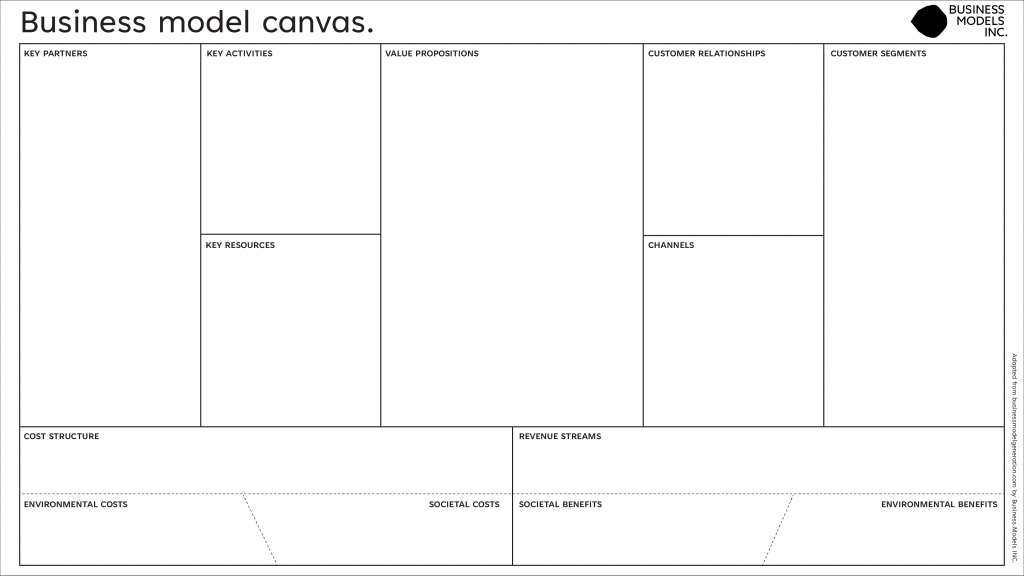As a startup founder, your vision might be crystal clear, but translating it into a viable business model can be a challenge. Here’s where the Business Model Canvas comes in – a powerful tool to map out your core business strategy.
what’s in the article
- What is Model Canvas?
- What each block of Model Canvas means
- Why a Properly Filled Business Model Canvas Matters

What is Model Canvas?
The Canvas is a visual framework with nine key building blocks that define how your startup creates, delivers, and captures value.
By filling out the Business Model Canvas, you gain a holistic understanding of your business’s core elements. This allows you to identify potential weaknesses, refine your strategy, and create a compelling narrative for investors or potential partners. Remember, the Canvas is a flexible tool. Don’t be afraid to iterate and adjust as your business evolves.
The Canvas is a visual framework with nine key building blocks that define how your startup creates, delivers, and captures value. Let’s break it down and see how using it effectively can be the difference between a successful venture and a missed opportunity.
What each block of Model Canvas means
Let’s break it down and see how to use it effectively:
Customer Segments
Who are your ideal customers? Are you targeting small businesses, busy professionals, or budget-conscious families? Clearly define your target audience(s).
Example: Let’s say you’re creating an on-demand laundry service. Your customer segments could be busy professionals with limited time and young families juggling work and childcare.
Value Propositions
What problem do you solve for your customers? How does your product/service make their lives better or easier? Highlight your unique selling points.
Example: For laundry service, the value proposition is convenience and time-saving. Customers can schedule pickups and deliveries through an app, eliminating the need for trips to the laundromat.
Channels
How will you reach your target audience? Think online advertising, social media marketing, partnerships with relevant businesses (e.g., apartment complexes).
Example: The laundry service could utilize social media marketing targeted towards busy professionals in their city. They could also partner with co-working spaces to offer a discount to their members.
Customer Relationships
How will you interact with your customers? Will it be through a self-service app, phone support, or a dedicated customer service team?
Example: The laundry service could offer a user-friendly app for scheduling, tracking orders, and making payments. They might also have a live chat option for quick customer support.
Revenue Streams
How will you generate revenue? Will you charge a subscription fee, a per-wash fee, or offer tiered pricing based on laundry volume?
Example: The laundry service could have a pay-per-wash model with additional fees for special services like dry cleaning or same-day delivery.
Key Resources
What assets are essential for your business to function? This could be technology, equipment, skilled personnel, or access to specific data sets.
Example: The laundry service’s key resources would include a fleet of delivery vehicles, a network of partner laundromats, and a robust app for managing orders and payments.
Key Activities
What critical actions does your business need to take to deliver value? This could be product development, marketing, customer service, or supply chain management.
Example: For the laundry service, key activities would involve laundry pickup and delivery, managing partnerships with laundromats, and ensuring quality control for cleaned clothes.
Key Partnerships
Who are your key collaborators? Are there suppliers, distributors, or other businesses that can help you achieve your goals?
Example: The laundry service could partner with eco-friendly detergent brands or local dry cleaners to offer additional services.
Cost Structure
What are the expenses associated with running your business? Consider fixed costs (rent, salaries) and variable costs (materials, per-wash fees).
Example: The laundry service’s cost structure would include vehicle maintenance, laundry service fees paid to partner laundromats, and employee salaries.

Looking to Build a Custom Startup Product without worries about strategy planning?
EVNE Developers is a dedicated software development team with a product mindset.
We’ll be happy to help you turn your idea into life and successfully monetize it.
Why a Properly Filled Business Model Canvas Matters
Think of the Business Model Canvas as your startup’s blueprint. A well-defined and well-reasoned Canvas offers a multitude of benefits:
Clarity and Focus
Filling out the Canvas forces you to think critically about every aspect of your business. It helps you identify potential weaknesses, inconsistencies, and areas that need further development. By clearly defining your target audience, value proposition, and revenue streams, you gain a laser focus on what truly matters for your startup’s success.
Communication and Alignment
The Canvas serves as a shared language for your team. It fosters clear communication and ensures everyone is on the same page regarding the company’s goals, target market, and overall strategy. This alignment is crucial for efficient decision-making and a unified approach to growth.
Investor Confidence
When seeking funding, a well-developed Business Model Canvas is a powerful tool to impress investors. It demonstrates a deep understanding of your market, a sound plan for delivering value, and a realistic path to profitability. Investors are more likely to back a startup that can articulate its business model clearly and concisely.
Adaptability and Innovation
The business landscape is constantly evolving. The Canvas is not a static document; it’s a dynamic tool that allows you to test assumptions, experiment with different strategies, and adapt to changing market conditions. By revisiting and revising your Canvas regularly, you can ensure your business remains agile and innovative.
So, grab a whiteboard, a sticky notepad, or your favourite online canvas template, and start mapping out your startup’s path to success with the Business Model Canvas!

About author
Roman Bondarenko is the CEO of EVNE Developers. He is an expert in software development and technological entrepreneurship and has 10+years of experience in digital transformation consulting in Healthcare, FinTech, Supply Chain and Logistics.
Author | CEO EVNE Developers


















